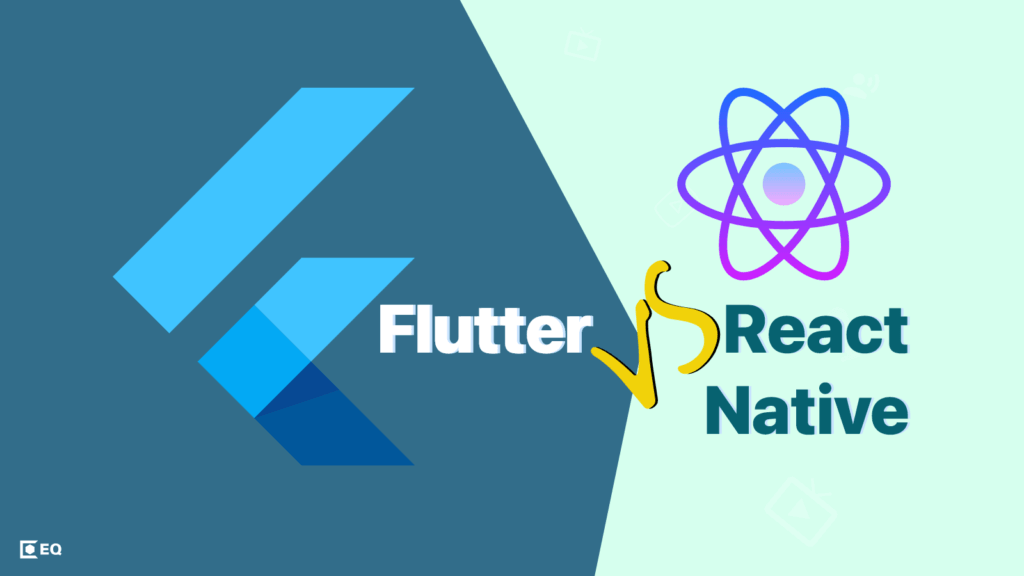Flutter and React Native are two of the most popular cross-platform mobile app development frameworks available today. Both frameworks allow developers to build high-quality apps for iOS and Android using a single codebase, saving time and effort compared to building separate apps for each platform.
In this comparison, we will look at the critical differences between Flutter and React Native, including programming language, user interface, performance, community, and development time. Understanding these differences can help developers make informed decisions when choosing a framework for their next mobile app project.
React Native vs Flutter
- Programming Language: React Native uses JavaScript, while Flutter uses Dart.
- User Interface: React Native uses native components to provide a traditional look and feel. At the same time, Flutter has its own unique widgets and designs.
- Performance: React Native can perform better with native modules, but Flutter has a faster development cycle and a hot reload feature.
- Community: React Native has a larger community and a more extended history, while Flutter has a growing community and faster-growing popularity.
- Development Time: React Native has a mature ecosystem and an extensive library of modules, which can make development faster for specific apps. At the same time, Flutter is known for more rapid app development due to its hot reload feature.
- Debugging: React Native provides better debugging options, while Flutter has a more efficient reload feature.
- Testing: Both React Native and Flutter have strong testing capabilities, but React Native has a larger pool of testing tools available.
- Documentation and Support: React Native has more comprehensive documentation and support. In contrast, Flutter has growing documentation and support from its growing community.
- App Size: Flutter tends to have larger app sizes than React Native.
- Community Contributions: React Native has a larger pool of third-party libraries and packages. In contrast, Flutter has a growing collection of contributions from its growing community.
What are Flutter’s Advantages
Flutter has many advantages, making it a good choice for mobile app development. It allows for faster app development with its “hot reload” feature, which shows real-time changes. It also has unique designs and widgets, making the app look different from others. The framework runs quickly and smoothly, providing a good experience for users. It’s easy to learn, open-source, and can be used for multiple types of app development, including web and desktop. Additionally, it has an extensive collection of pre-designed widgets to help create beautiful and functional apps.
Why choose React Native over Flutter?
React Native is a well-established framework for developing mobile apps and has several advantages over other frameworks, including Flutter. Here are some reasons why one might choose React Native over Flutter:
First, React Native has a larger and more mature community of developers. This can provide a wealth of support and resources, including third-party modules and libraries that can be used in the app. This larger community can also offer a pool of developers to draw from when looking to hire or bring new talent on board.
Second, React Native uses JavaScript, a widely-used programming language that many developers are already familiar with. This can make it easier to find developers with the right skills and reduce the time and cost required to train new hires.
Third, React Native uses native components, the building blocks of native apps, to create a traditional look and feel. This can help to create a more familiar and intuitive experience for users. Additionally, using native components can also lead to better performance compared to using custom widgets.
Fourth, React Native provides better debugging options, making it easier for developers to find and fix bugs. This can save time and effort and can result in a higher-quality app.
Finally, React Native has a broader range of testing tools available, making testing the app easier and ensuring its quality. This can help catch bugs early in the development process and prevent the app from crashing or behaving unexpectedly for users.
So which framework is better?
Neither React Native nor Flutter is objectively “better,” as the choice of framework depends on the specific requirements and goals of the project. Both frameworks have unique strengths and weaknesses, and the best option depends on the particular needs of the project, the team’s expertise, and other factors.
For example, if a developer is familiar with JavaScript and wants to use a framework with a larger community, React Native may be a better choice. On the other hand, if a developer wants to create a highly customized and visually stunning app, Flutter may be the better option due to its extensive widget library and ability to create beautiful, fast animations.
Ultimately, the best framework choice will depend on the specific requirements and goals of the project. Therefore, it’s essential to carefully evaluate both frameworks and consider factors such as performance, scalability, development time, and cost before making a decision.
Bonus: Some of the best starter templates for both framework
- React Native Starter Kit: A comprehensive starter kit that includes multiple features and screens, providing a good starting point for building a React Native app.
- react-native-firebase-starter: A starter template that integrates with Firebase for authentication, real-time database, and storage.
- React Native Redux Boilerplate: A starter kit that integrates Redux, a popular state management library, and provides a solid foundation for building scalable React Native apps.
For Flutter:
- Flutter Starter Kit: A comprehensive starter kit with many features and screens, providing a good starting point for building a Flutter app.
- Flutter Firebase Starter: A starter kit that integrates with Firebase for authentication, real-time database, and storage
